LG G7 ThinQ vs Samsung Galaxy S9
The LG G7 ThinQ is here, and with a big, sharp screen, top-end specs and a glass and metal build it’s clearly gunning for the top phones on the market, which makes the Samsung Galaxy S9 perhaps its biggest competition.
Samsung’s latest is a modest upgrade on the Galaxy S8, but still manages to be one of the best – not to mention best-selling – Android phones around, thanks to its curvy display and flagship features.
The G7 ThinQ and Samsung Galaxy S9 have plenty in common and plenty more that’s different. So we’ve compared their specs, design and features to help you choose between them.
Watch our hands on LG G7 ThinQ video below to see the phone in action
LG G7 ThinQ vs Samsung Galaxy S9 design
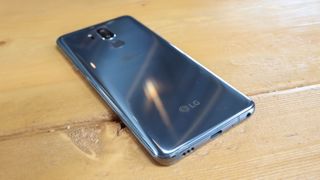
Whatever color you choose, you're getting a shiny glass back with the G7 ThinQ
The LG G7 ThinQ has glass panels on the front and back with a metal frame sandwiched between them. It’s a familiar design, which we’ve seen variations of on numerous phones now, including the Samsung Galaxy S9, which also has a glass back and a metal frame.
Both phones are also IP68 certified dust and water-resistant, though the LG G7 ThinQ might be slightly tougher, as it additionally meets MIL-STD 810G military standards.
Both phones have small bezels and a fingerprint scanner on the back, and both have a speaker grille on the bottom edge – though the Galaxy S9 also has a second speaker in the earpiece, while the LG G7 ThinQ relies on just one but uses the inside of the phone as a resonance chamber to boost the bass.
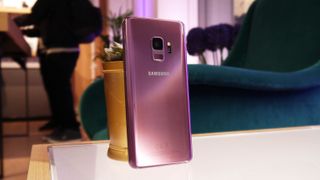
The Samsung Galaxy S9 looks somewhat similar from the back
Visually, many of the design differences are tied to screen, which we’ll cover below, but the two handsets are available in a different selection of colors, with the Galaxy S9 coming in Midnight Black, Coral Blue, Titanium Grey and Lilac Purple, while the LG G7 ThinQ comes in New Platinum Grey, New Aurora Black, New Moroccan Blue and Raspberry Rose colors.
They also have different dimensions and weights, as the LG G7 ThinQ is 153.2 x 71.9 x 7.9mm and 162g, and the Samsung Galaxy S9 is 147.7 x 68.7 x 8.5mm and 163g. So the main difference there is that the Galaxy S9 is shorter and thicker.
LG G7 ThinQ vs Samsung Galaxy S9 display
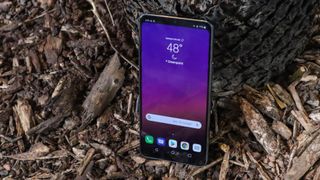
The LG G7 ThinQ's screen is bigger and flatter than the S9's
The LG G7 ThinQ has a 6.1-inch 1440 x 3120 LCD screen with a pixel density of 564 pixels per inch. It’s bright, topping out at 1,000 nits, and it has a 19.5:9 aspect ratio, which means it’s taller than a typical 16:9 phone.
The Samsung Galaxy S9 has a slightly smaller 5.8-inch display, with a resolution of 1440 x 2960 and a pixel density of 570 pixels per inch. So far, so similar other than the size, and the aspect ratio of 18.5:9 is similar too. The Galaxy S9 can also reach similar levels of brightness.
If you want something bigger, the Samsung Galaxy S9 Plus with a 6.2-inch screen is also available.
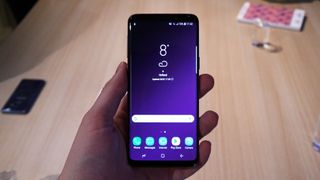
The Galaxy S9 has a curved Super AMOLED screen
Here's where they get very different: the S9 uses a Super AMOLED screen rather than an LCD one, which typically allows for superior contrast and more vivid colors – we’ll let you know exactly how well the G7 ThinQ’s screen performs when we’ve put it through a full review, but the Galaxy S9’s is one of the best around.
Samsung’s screen is also curved, while the G7 ThinQ is flat, but the LG G7 ThinQ’s display has a notch, which the Samsung Galaxy S9 doesn’t, so in appearance, size and technology there are quite a lot of differences here.
LG G7 ThinQ vs Samsung Galaxy S9 OS and power
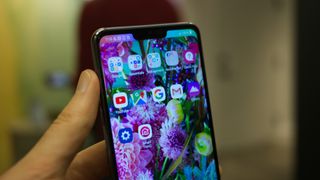
Both phones run Android Oreo
The LG G7 ThinQ and Samsung Galaxy S9 both run Android 8 Oreo, overlaid with their own skins. They also both have a dedicated AI hardware button, but while the LG G7 ThinQ’s is used to launch Google Assistant, Samsung’s launches its Bixby assistant, arguably making it less useful.
Specs are somewhat similar, as the LG G7 ThinQ packs an octa-core Snapdragon 845 chipset, 4GB of RAM and 64GB of storage (though some regions will get an LG G7 Plus ThinQ with 6GB of RAM and 128GB of storage), while the Galaxy S9 has 4GB of RAM, 64GB of storage and either a Snapdragon 845 chipset or a similarly powerful Exynos 9810 one, depending on where you are in the world.
Both phones have high-end specs then and we can attest that the Galaxy S9 is a top performer. The LG G7 ThinQ is likely to be as well, but we’ll let you know when we’ve properly put it to the test.
LG G7 ThinQ vs Samsung Galaxy S9 camera and battery
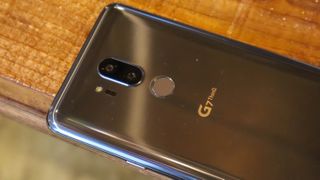
The LG G7 ThinQ has one more camera lens than the Galaxy S9
There’s a dual-lens camera on the back of the LG G7 ThinQ, specifically a 16MP f/1.6 primary lens and a 16MP f/1.9 wide-angle one. The phone also offers AI-powered scene recognition and a Super Bright mode, which cuts image quality down to 4MP, but makes shots up to four times brighter, so it could be handy in poor lighting.
The Samsung Galaxy S9 meanwhile has just a single lens rear camera, but it’s a 12MP one with a variable aperture, able to switch between f/1.5 and f/2.4. In our tests we found it highly capable, even in low light, so the G7 ThinQ might have some competition there.
Both phones have an 8MP front-facing camera, but it’s an f/1.9 wide-angle one in the case of the LG G7 ThinQ and a more conventional f/1.7 one on the Samsung Galaxy S9.
Both phones also have a 3,000mAh battery. We’ll let you know how the LG G7 ThinQ’s holds up when we’ve put it through a full review, but the Galaxy S9’s isn’t great, sometimes struggling to even make it through a day.
Takeaway
There’s plenty to consider if you’re deciding between a Samsung Galaxy S9 and an LG G7 ThinQ. While the phones are likely to be similarly powerful, they have very different camera setups, different screen sizes and technology, different designs and different audio skills.
Samsung’s phone impressed us, but didn’t blow us away, achieving four stars in our review, so the LG G7 ThinQ could prove a viable alternative depending on what you want from your phone and how well it holds up in key areas like battery life.
Cost is another consideration – we don’t yet know how much the LG G7 ThinQ will cost but Samsung’s phone is expensive, coming in at £739, $719.99, or AU$1,199 SIM-free. So keep an eye out for our full LG G7 ThinQ review, where we’ll dig into exactly how good it is and how good value.

Post a Comment